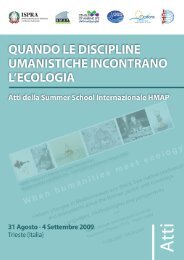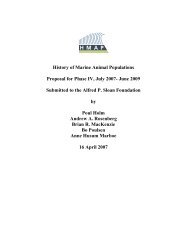The Danish fisheries c.1450-1800. Medieval and early modern ...
The Danish fisheries c.1450-1800. Medieval and early modern ...
The Danish fisheries c.1450-1800. Medieval and early modern ...
You also want an ePaper? Increase the reach of your titles
YUMPU automatically turns print PDFs into web optimized ePapers that Google loves.
<strong>The</strong> Limfjord herring was reported to be caught in large quantities in 1808, exactly<br />
the year when the Bohuslen fishery collapsed. <strong>The</strong> following years to 1832 saw a renewed<br />
rise of the Limfjord herring fishery. <strong>The</strong> towns of Aalborg <strong>and</strong> Nibe experienced tremendous<br />
wealth at a time when the rest of the country suffered the consequences of Denmark’s<br />
misfortune in the Napoleonic wars. Extant records of the catches per day through one year of<br />
a typical fishing weir reveals a very high productivity. In 1825, however, the s<strong>and</strong> dunes<br />
which blocked the inflow of salt water from the North Sea to the Limfjord were breached by a<br />
flood, <strong>and</strong> the fiord turned salty after 800 years of brackish conditions. <strong>The</strong> consequences to<br />
the herring stock seemed beneficial at first. <strong>The</strong> catches rose to an all time high over the next<br />
three years but then catches dwindled dramatically. By 1832 the fishery was considered<br />
extinct.<br />
<strong>The</strong> Bohuslen fishery<br />
<strong>The</strong> Aalborg <strong>and</strong> Buhuslen fish merchants seem to have experienced alternating fates through<br />
the sixteenth to <strong>early</strong> nineteenth century. <strong>The</strong> bleak 1660s of Aalborg were good years for<br />
Bohuslen, <strong>and</strong> again the decline of Aalborg in the 1750s was matched by an unprecedented<br />
growth of the Bohuslen fishery. For this paper, which is concerned only with the <strong>Danish</strong><br />
sources, we shall restrict ourselves to the sixteenth-century evidence. Bohuslen was then a<br />
Norwegian province <strong>and</strong> therefore under <strong>Danish</strong> administration.<br />
<strong>The</strong> main source of information for the fishery is the Sound Toll Tables which are<br />
registers of ships entering the <strong>Danish</strong> Sound <strong>and</strong> paying a due according to the nationality of<br />
the owner of goods on board. As <strong>Danish</strong>, Norwegian, Lübeck <strong>and</strong> indeed for most of the time<br />
Swedish ships were exempt from the tax the records are less than perfect. However, they do<br />
provide us with minimum figures of the transit trade <strong>and</strong> treated cautiously may provide us<br />
with important information. <strong>The</strong> source is available annually from 1557 <strong>and</strong> Figure 8






